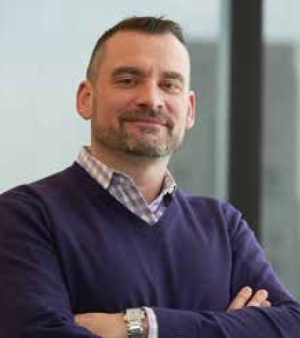by
Sean Ruck, Contributing Editor | June 06, 2017
From the June 2017 issue of HealthCare Business News magazine
Radiochemist Jason Lewis is the director of the Center for Molecular Imaging and Nanotechnology at Memorial Sloan Kettering Cancer Center (MSK) in Manhattan. He recently took some time to talk about the work being done in his lab and some of the exciting advances in medicine.
HCB News: What inspired you to become a scientist?
JL: I just found it intriguing. As a child, there was a program in the U.K. called Tomorrow’s World that I watched and was inspired by. I really can’t remember a time I didn’t want to be involved in science.



Ad Statistics
Times Displayed: 172725
Times Visited: 3125 For those who need to move fast and expand clinical capabilities -- and would love new equipment -- the uCT 550 Advance offers a new fully configured 80-slice CT in up to 2 weeks with routine maintenance and parts and Software Upgrades for Life™ included.
HCB News: How long have you been with MSK?
JL: I’ve been here nine years, coming here after 12 years at Washington University School of Medicine in St. Louis.
HCB News: What attracted you to a career at MSK?
JL: The fact that there was the clear ability to translate novel molecular probes into patient use. Memorial Sloan Kettering is second to none in that regard due to the strong support they give to research. Clinical translation is one of MSK’s main missions and there’s a great infrastructure for it.
HCB News: I saw that the MSK lab is called “The Jason Lewis Lab.” Was it started up under you?
JL: When I joined MSK, there was already an active radiochemistry program, but I was given three main tasks. The first was to build a new GMP cyclotron facility. The second was to lead a team of faculty, at 12 members now, as their service chief. The third was to start my laboratory. I think I have been able to build all three to meet MSK’s radiochemistry and molecular imaging probe research needs. I’ve also been named the vice chair for research of the Department of Radiology, which is somewhat unusual for a non-M.D. to be vice chair of a clinical department, and that brings its own set of challenges and possibilities.
HCB News: You mentioned the new cyclotron facility. Was that a new piece for Memorial Sloan Kettering?
JL: It was our second cyclotron, but in a fully GMP-compliant facility. We are able to use it to create fluorine-18, carbon-11 and other isotopes. Our other machine is located four blocks away and provides other long-lived isotopes as well.
HCB News: A lot of news was offered about your work with imaging agents. Can you discuss some of the advancements you’re most excited about?
JL: We have an extensive investigational new drug or IND list. There are 35 different tracers we can use in clinical trials here. We average about four to five new imaging and therapy probes into the clinic per year. One recent example is our work with carbon-13 pyruvate as a hyperpolarized MRI probe. All the pharmacy work is done in the new GMP facility, supporting the manufacture and supply of all manners of molecular imaging probes.

